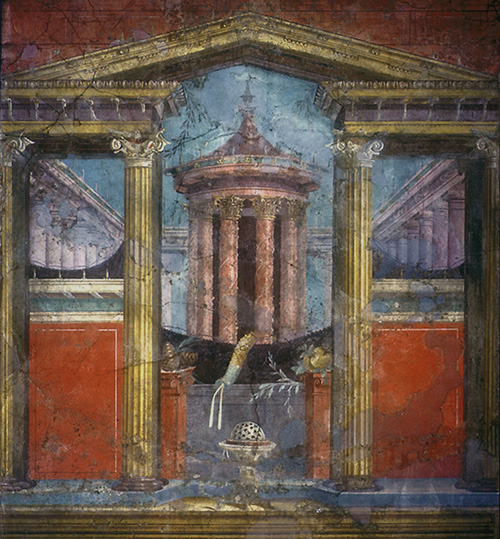Generally speaking Romano-Campanian wall-painting, as it is collectively referred to, is grouped into four successive Styles. These are based on a typological classification proposed by the German archaeologist August Mau, in his influential 1910 publication Pompeii: its life and art. His typology originally described them as the Incrustation, Architectural, Ornate and Intricate Styles, but now they are usually referred to as the First, Second, Third and Four Styles. For further discussion on Mau’s classification system see The False-Door: dissolution and becoming in Roman wall-painting (Owen 2010: 1-20).
The tragic-style wall-paintings that De Chirico’s paintings resonate with exhibit many of the architectural features associated with the ‘Architectural’ Second Style and are collectively identified by the use of entrance motifs leading to sacred spaces (fig.1). Whilst it is true that Second Style wall-paintings were discovered prior to his metaphysical paintings, the tragic-style paintings that shed the clearest light on De Chirico’s shadowy enigmas were either still in limbo or generally unavailable via illustrations, at the time he created his metaphysical paintings. This is not a case of history repeating itself but one of those rare instances in which the present pre-empts the past.
The tragic-style wall-paintings that were discovered prior to the production of his metaphysical oeuvre were rarely illustrated because contemporary ‘taste’ favoured wall-paintings depicting mythological scenes rather than the figureless tragic-style, which was primarily architectonic. An advertisement for the 1886 publication Dipinti murali di Pompei in the 1887 20 June issue of the New York Times, echoes this view. “The 20 large plates finished last year by Richter & Co., of Naples, and issued by Cavalier Pasqualé d’Amelio, with Italian and French comments in parallel columns, bring into prominence the architectonic side of Pompeiian wall painting”. However, the ‘architectonic’ wall-paintings that the 1886 publication brought into ‘prominence’, contained none of the deep perspectives associated with the tragic-style, but only the later and much more planar ‘Ornate’ and ‘Intricate’ Third and Fourth Styles, as defined by August Mau. The fact that many figurative vignettes were cut out of large architectonic compositions for museum display, or even worse to be sold to private buyers, further substantiates the then contemporary preferences for paintings that depicted mythological scenes. 1
1